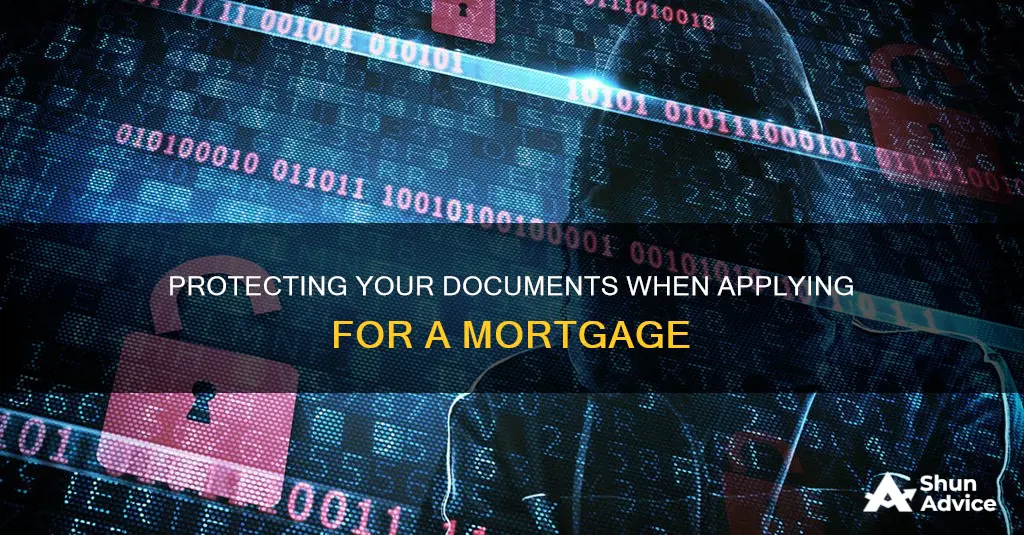
Applying for a mortgage requires sharing a lot of personal and financial information, which can be scary as it leaves you vulnerable to identity theft and fraud. However, there are many ways to protect your documents and personal information when applying for a mortgage. Firstly, it is important to only share information with reputable and trusted lenders and to be cautious of red flags. You should also ask your lender about their privacy and security policies, and only submit your application over a secure network.
| Characteristics | Values |
|---|---|
| Submission of application | Submit application over a secure network only. Avoid public networks. |
| Lender | Choose a reputable lender. Check reviews and ensure they are licensed through the Nationwide Mortgage Licensing System and Registry. |
| Communication | Be cautious when responding to emails. Verify the email address before responding. |
| Privacy policy | Ask the lender about their privacy and security policies. |
| Uploading documents | Use a secure portal for uploading documents. |
| Identity verification | Keep documents such as passport, driving license, tax records, bank statements, etc., ready. |
| Home warranty | Get a home warranty that covers your home's systems and appliances. |
What You'll Learn

Use a secure network when applying online
When applying for a mortgage online, it is imperative to use a secure network to protect your documents. Here are some detailed steps to ensure a secure online application process:
Use a Secure, Private Network
Avoid applying for a mortgage over a public network or using public Wi-Fi. Public networks are often unsecure, making it easier for cybercriminals to intercept your application and steal sensitive information. Ensure that your home Wi-Fi network is password-protected, and consider using a virtual private network (VPN) for an extra layer of security.
Verify the Lender's Portal Security
Before submitting any documents, confirm that your chosen lender has a secure online portal for uploading documents. Look for indicators like a padlock symbol, and inquire about their security practices. Reputable lenders will use encrypted software and may offer two-factor authentication for added security.
Be Cautious with Emails
While email communication with your loan officer may be convenient, it is not always the safest method. Avoid sending documents with personal information via email unless you are certain that encryption is used. Always double-check the sender's email address, and when in doubt, contact your loan officer via phone or in person to verify the legitimacy of any requests.
Choose a Reputable Lender
Opt for well-known and trusted mortgage lenders or banks. Do your due diligence by checking their privacy and security policies, and confirm that they are licensed through the Nationwide Mortgage Licensing System and Registry. Additionally, look for lenders with a track record of satisfied customers, as this indicates that they prioritize the safety of your information.
Strong Passwords and Two-Factor Authentication
Ensure that your online accounts related to the mortgage application have strong, unique passwords. When given the option, enable two-factor authentication, which adds an extra layer of security by requiring an additional form of verification beyond your password.
By following these steps, you can enhance the security of your documents and personal information when applying for a mortgage online.
Moving Your Mortgage: A Guide to Smooth Transitioning
You may want to see also

Verify the lender's legitimacy
When applying for a mortgage, it is crucial to verify the legitimacy of the lender to protect your personal and financial information. Here are some detailed steps to help you confirm the legitimacy of a mortgage lender:
Firstly, only use mortgage lenders that are well-known and trusted. It is essential to do your due diligence and research the lender before providing any sensitive information. Check if the lender is licensed through the Nationwide Mortgage Licensing System and Registry. This system ensures that the lender complies with specific standards and ethical guidelines to protect your information. You can also verify their licensing status and registration with your state's financial regulatory agency.
Secondly, consider the lender's reputation and history. Check customer reviews, BBB ratings, and online reviews to gauge the experiences of previous borrowers. A lender with a long-standing reputation and repeat customers is generally a safer option. Additionally, look for lenders who provide accessible, professional, and transparent customer support. Legitimate lenders should be transparent and willing to address any concerns you may have about their security practices.
Thirdly, be cautious of red flags and common scam warning signs. Legitimate lenders typically don't make unsolicited calls, guarantee loan approval, or request upfront fees. Be wary of lenders who create a false sense of urgency, harass you, or pressure you to act quickly. Reputable lenders will not ask for payment through unconventional methods like cryptocurrency or gift cards.
Lastly, pay attention to the lender's website and security measures. Look for security indicators like the VeriSign logo or a padlock symbol before submitting any personal information online. Ensure they provide a secure online portal for document submission and communication. Additionally, confirm that they use encrypted software when sending emails to protect your data from potential interception.
Remember, taking the time to verify a lender's legitimacy is crucial to protect yourself from identity theft and financial loss. Follow these steps to increase your confidence in the legitimacy of your chosen mortgage lender.
Requesting a Payoff: A Guide to Phh Mortgage
You may want to see also

Check for a secure document upload portal
When applying for a mortgage, you will likely be asked for personal information such as tax records, employment history, pay stubs, bank statements, and more. This is necessary for lenders to check your credit history and confirm your income, but it also means that your sensitive data could be at risk.
One way to ensure your documents are protected when applying for a mortgage is to check for a secure document upload portal. This is a safer alternative to sending documents via email, which is not recommended due to the risk of interception by thieves. A secure document upload portal allows you to drag and drop your files onto a window, which are then uploaded via a secure connection directly to the lending institution's data center. Some companies, like Wisconsin Mortgage Corporation, provide a Consumer Portal for this purpose and discourage sending documents via email.
A secure document upload portal can also be set up with or without password protection. While password protection adds an extra layer of security, it is not necessary for ensuring a safe transfer of documents. The destination server for these portals only allows uploading and not viewing of files, so even if someone gets a copy of the link, they can only upload fake files. However, it is important to exercise caution if any information looks suspicious.
In addition to using a secure document upload portal, there are other steps you can take to protect your documents when applying for a mortgage. This includes only working with reputable lenders, submitting your application over a secure network, and being cautious when responding to emails. By taking these precautions, you can help ensure that your personal information remains secure throughout the mortgage application process.
Making Mortgage Payments: Wells Fargo Guide
You may want to see also

Be cautious when responding to emails
Emails are a fast and convenient way to correspond with your loan officer when applying for a mortgage. However, it is not always the safest method of communication, so it is important to proceed with caution. Here are some ways to be cautious when responding to emails during the mortgage application process:
Double-check the sender's email address: Always verify the sender's email address before responding to email requests. If you do not recognize the email address or if the email appears suspicious, do not respond. Instead, contact your loan officer directly by phone or in person to confirm the legitimacy of the email.
Be wary of phishing attempts: Many thieves send out phishing emails with the intent of tricking recipients into providing personal and financial information. Do not open suspicious emails or respond to requests for sensitive information. If you are unsure, contact your loan officer or a local loan expert for advice.
Use secure methods to share information: Avoid sending sensitive information, such as tax records, employment history, pay stubs, or bank statements, directly via email. Instead, use a secure online portal provided by your lender or financial institution. If an online portal is not available, consider delivering the paperwork in person or faxing the documents directly to the recipient.
Verify closing instructions: During the closing process of your mortgage, be cautious of exchanging any details or instructions for wiring funds via email. Scammers may pose as trusted individuals, such as real estate agents or legal representatives, to provide false payment instructions. Always verify closing instructions, including account names and numbers, with trusted representatives in person or over the phone.
Protect your personal information: Be mindful of the personal information you provide in emails. Identity thieves can use this information to steal your identity or engage in fraudulent activities. Only provide sensitive information to reputable and trusted lenders, and ask about their privacy and security policies to ensure your data is protected.
Exploring Options: Strategies to Temporarily Pause Mortgage Payments
You may want to see also

Ask about the lender's privacy policy
Applying for a mortgage requires sharing sensitive personal information with the lender. This may include your tax records, employment history, paystubs, social security number, bank statements, and more. As such, it is important to ask about the lender's privacy policy to ensure that your information is protected and will not be shared without your consent.
Firstly, inquire about the lender's data retention and destruction policies. Ask if they have a records retention program and how they handle the disposal of sensitive information. For example, do they destroy, erase, or make the data unreadable before disposal? Understanding their data retention practices can help you gauge their commitment to protecting your information even after your relationship with them has ended.
Secondly, ask about the lender's security measures. Find out if they use encryption software for email communication and whether they provide a secure online portal for document uploads. Encryption is crucial for protecting your information during transmission, while a secure portal ensures that your documents are safely stored. Also, inquire about their physical security measures, such as restricted access to their offices or servers.
Additionally, clarify with the lender who will have access to your information within their organization. Ask about their user access controls and whether they have policies in place to restrict access to only authorized individuals. Understand the scope of sharing within their company and with any third parties. Ask for a list of third parties they share data with and confirm that these entities have strong privacy and security practices as well.
Lastly, review the lender's privacy policy document. This document should outline their data handling practices, including the types of data collected, how it is used, stored, and shared, as well as your rights as a data subject. Pay close attention to the details and ask for clarification if needed. By reviewing the privacy policy, you can identify any potential red flags and make an informed decision about sharing your personal information with the lender.
A Guide to Understanding and Applying for a Mortgage
You may want to see also
Frequently asked questions
Only apply for a mortgage over a secure, password-protected network. Avoid applying for a mortgage in public places, as public networks are often unsecured and can make it easier for thieves to hack into your system and steal your information.
Only use mortgage lenders that are well-known and trusted. Check that your lender is licensed through the Nationwide Mortgage Licensing System and Registry. If you're on a website, look for the VeriSign logo or a padlock in the search bar.
Ask your lender about their privacy and security policies. Your lender should provide you with a secure online portal or use encryption software that protects your information. If an online portal is unavailable, deliver the paperwork in person or fax the documents directly to the bank.







